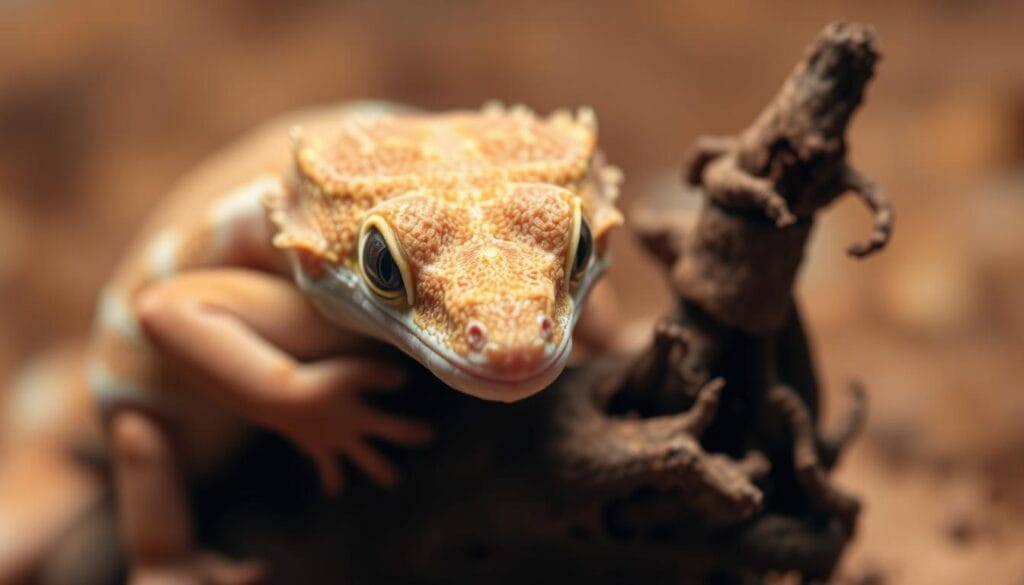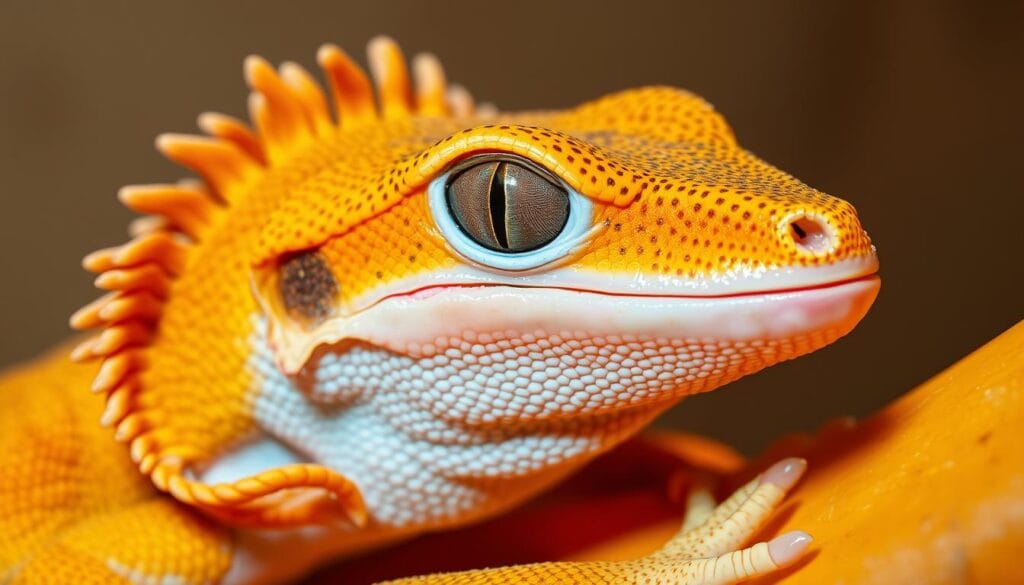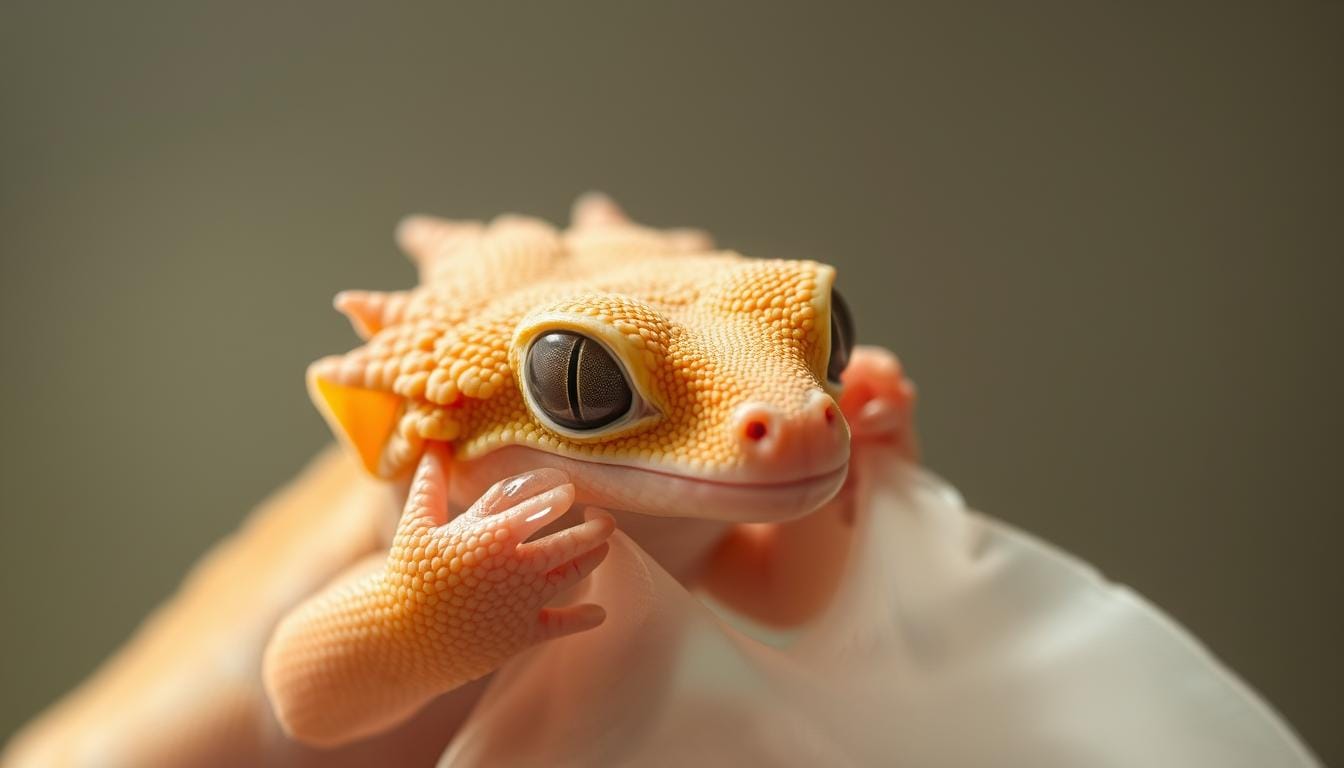Helping your crested gecko shed is key to their health. Knowing how they shed can greatly improve their well-being. These nocturnal animals go through a natural skin renewal cycle. They need the right care and environment to thrive.
Shedding is a big part of a crested gecko’s life. Young ones shed every 2-4 weeks, while adults do it about every 4-8 weeks. Taking good care of them during shedding can keep them healthy and happy.
Table of Contents
Understanding the Shedding Process in Crested Geckos
Shedding is a natural and important process for crested geckos. It helps them grow and stay healthy. Knowing about shedding is key to caring for your reptile friend.
The first step in helping your gecko is to understand why they shed. Unlike humans, reptiles shed their skin to grow and fix damaged skin.
What is Shedding?
Shedding is when crested geckos get rid of their old skin. This process is essential for:
- Removing damaged skin layers
- Supporting growth
- Preventing parasites
- Maintaining healthy skin condition
When Does Shedding Occur?
Shedding happens at different times based on age and growth:
- Juvenile geckos: Shed about every 2-4 weeks
- Adult geckos: Shed every 4-8 weeks
Signs Your Gecko is About to Shed
Knowing the signs of shedding helps you help your gecko. Look for these signs:
- Skin appears dull and dry
- Slight color changes
- Decreased appetite
- Increased irritability
- Seeking rough surfaces to aid skin removal
Up to 70% of geckos show these signs before shedding. By recognizing these signs, you can help your crested gecko shed smoothly.
Proper Habitat Setup for Successful Shedding
Creating the perfect environment is key for your crested gecko’s shedding. A well-designed habitat supports safe shedding and keeps your pet healthy and comfortable.
Ideal Temperature and Humidity Levels
Keeping the right temperature and humidity is vital. Crested geckos need specific conditions for smooth skin renewal:
- Humidity range: 60-80% during shedding periods
- Daytime temperature: 26-28°C (78-82°F)
- Nighttime temperature: 18-20°C (64-68°F)
Use a reliable hygrometer to check humidity levels. Consistent moisture is key to avoid shedding problems. Misting the enclosure helps keep humidity just right.
Substrate Choices for Shedding Comfort
Choosing the right substrate is crucial for safe shedding. Here are some good options for skin renewal:
- Coconut fiber substrate
- Moss-based mixtures
- Reptile-specific moisture-retaining substrates
A shedding box with damp moss can add extra humidity. This special area helps your crested gecko shed smoothly.
Pro tip: Always monitor your gecko’s shedding process and adjust habitat conditions as needed.
Regular health checks and environmental adjustments help your crested gecko shed comfortably and stress-free.
Diet and Nutrition Impact on Shedding
Nutrition is key for your crested gecko’s shedding. A balanced diet helps keep their skin healthy. This supports smooth shedding.
Creating the right diet is crucial. It prevents shedding problems and keeps your gecko healthy. The right nutrients can greatly improve shedding.
Key Nutrients for Healthy Skin
Good nutrition includes several important parts:
- Calcium supplements for strong bones
- Vitamin D3 for better calcium use
- Protein from insects
- Commercial diet as main food
Foods to Avoid Before Shedding
Some foods can make shedding harder. You should limit or avoid them:
- Too many fruit treats
- Unbalanced insect diets
- Lack of nutritional variety
| Nutrient | Importance for Shedding | Recommended Sources |
|---|---|---|
| Calcium | Supports skin elasticity | Calcium powder, crickets |
| Vitamin D3 | Enhances nutrient absorption | Supplements, UVB lighting |
| Protein | Promotes skin health | Gut-loaded insects |
Pro tip: Adult crested geckos need food every other day. Their diet should be 80% commercial diet, 10% insects, and 10% fruits. This keeps them healthy and supports good shedding.
Handling Your Crested Gecko During Shedding

Helping your crested gecko shed gently is important. Shedding can be delicate. Your actions can greatly affect their comfort and health.
Knowing how to shed safely is key for your pet’s health. Young geckos shed more often, every few weeks. Adults shed about once a month.
Essential Do’s During Shedding
- Minimize handling during the shedding process
- Maintain humidity levels between 60-80%
- Provide smooth surfaces for natural shedding assistance
- Monitor skin condition closely
Critical Don’ts to Remember
- Never pull or forcibly remove stuck shed
- Avoid handling your gecko extensively
- Do not use sharp objects near the gecko
- Prevent sudden temperature changes
Minimizing Stress During Shedding
Stress can mess up shedding. Keep things calm with steady temperatures of 70-75°F. Observation is key – look for dull skin and color changes to know it’s time to shed.
If shedding troubles last, see a reptile vet. About 10-20% of crested geckos need help with shedding issues.
Recognizing Shedding Complications
Crested gecko shedding can sometimes present challenges that require careful attention. Understanding the signs of stuck shed and potential shedding problems is crucial for maintaining your pet’s health and preventing serious complications.
Symptoms of Stuck Shed
Recognizing a stuck shed early can prevent potential health issues for your crested gecko. Look out for these critical signs:
- Patches of old skin remaining on the body
- Constricted areas around toes, tail, or eyes
- Dull or discolored skin appearance
- Difficulty moving or apparent discomfort
When to Seek Veterinary Help
Some shedding problems require professional intervention. You should contact a reptile veterinarian if you notice:
- Skin constricting circulation on toes or tail
- Persistent stuck shed lasting more than a week
- Signs of infection around shed areas
- Behavioral changes indicating significant discomfort
Shedding problems can stem from various factors, including inadequate humidity levels or nutritional deficiencies. Maintaining proper environmental conditions is key to preventing stuck shed situations in crested geckos.
Pro tip: Create a humid hide to help your gecko manage shedding more effectively and reduce the risk of stuck shed complications.
Regular monitoring of your crested gecko‘s shedding process can help you catch and address potential issues before they become serious health concerns. Maintaining optimal humidity between 60-80% and providing a balanced diet rich in essential nutrients will support healthy shedding cycles.
Tips for Supporting a Smooth Shedding

Keeping your crested gecko healthy and comfortable is key. Shedding can be tough for these reptiles. But, with the right steps, you can make it easier.
Creating the perfect environment is vital for shedding. Crested geckos need specific conditions for a healthy shed cycle.
Providing Moist Hides
Moist hides are a big help for shedding geckos. These spots keep your gecko moist during shedding. Here are some tips:
- Use a small container with damp moss or coconut fiber
- Maintain humidity levels between 50-70%
- Replace the substrate regularly to prevent mold growth
- Ensure the hide is large enough for your gecko to comfortably fit inside
Bathing Your Crested Gecko
Bathing isn’t always needed but can help. Here’s how to do it gently:
- Use lukewarm water (never hot)
- Create a shallow bath, just deep enough to cover the gecko’s legs
- Limit bath time to 5-10 minutes
- Never force your gecko to stay in the water
Shedding frequency changes with age. Adults shed every 4-8 weeks. Young ones shed more often because they grow faster.
| Shedding Stage | Recommended Care |
|---|---|
| Pre-Shedding | Increase humidity, provide moist hide |
| During Shedding | Minimize handling, ensure proper moisture |
| Post-Shedding | Check for complete shed, inspect for any retained skin |
Remember, patience is key when helping your crested gecko through the shedding process. Always watch your pet closely. If shedding problems persist, see a reptile vet.
Post-Shedding Care
After your crested gecko sheds, it’s important to take good care of its skin. Watching over your gecko closely is key to keeping it healthy and happy.
Drinking water is very important for your gecko’s recovery. Your gecko might feel a bit weak after shedding. So, making a safe space for it is very important.
Importance of Hydration
Drinking water is crucial right after shedding. Here are some tips to help:
- Mist the enclosure gently to keep humidity right
- Give fresh water in a clean, shallow dish
- Make sure water is easy for your gecko to find
A well-hydrated gecko will have stronger skin. It will also shed easier in the future.
Checking for Skin Quality
Check your gecko’s new skin carefully. Look for:
- Old skin completely gone
- No shed left on toes or tail tip
- Smooth, even skin texture
- No signs of irritation or odd color
*”A thorough post-shedding examination can prevent potential health complications.”*
Watching your crested gecko’s shedding closely helps spot health problems early. This keeps your pet in top shape for its whole life.
Common Myths About Shedding
Crested gecko shedding is often misunderstood. Knowing the truth can help you care for your reptile better.
Many people believe wrong things about crested gecko shedding. Let’s clear up some common myths.
Debunking Popular Misconceptions
- Myth: All geckos shed at exactly the same rate
Reality: Young crested geckos shed about once a week. Adults shed once a month or every couple of months. It depends on age, health, and growth.
- Myth: Shedding problems are always a serious health issue
Minor shedding issues can be fixed with the right humidity and care. Not every incomplete shed needs a vet.
- Myth: Forced shedding helps remove stuck skin
Forcing off shed skin can hurt your gecko’s scales. Be patient and keep the area moist for natural shedding.
Understanding Individual Needs
Every crested gecko is different. Shedding patterns vary due to several factors:
| Factor | Impact on Shedding |
|---|---|
| Age | Younger geckos shed more during growth spurts |
| Nutrition | A good diet helps skin health and shedding |
| Habitat Conditions | Right humidity is key for smooth shedding |
Knowing these differences helps you tailor care for your gecko’s shedding needs.
Resources for Further Assistance
Dealing with crested gecko shedding can be tough. But, there are many resources to help you. Books and online groups offer great tips on safe shedding and caring for your gecko.
Looking for detailed info? Check out “The Complete Crested Gecko” by Advanced Reptile Specialists. Also, sites like Reptile Forums UK have lots of helpful advice. They can teach you a lot about keeping your gecko healthy, including during shedding.
Expert Recommended Guides
Facebook and Reddit have reptile care groups where experts share their knowledge. Websites like ReptilesMagazine.com and forums are great for getting advice. They can help with your gecko’s shedding and answer your questions.
Online Communities and Support
Learning is important for your gecko’s care. By staying up-to-date and talking to reptile lovers, you’ll get better at caring for your gecko. This way, you can ensure safe shedding and keep your gecko happy and healthy.

